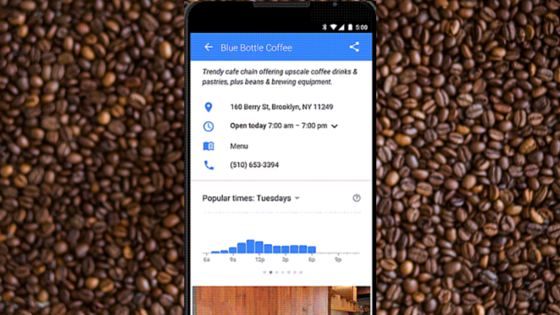Google is rolling out a new feature showing “the busiest times of the week for millions of places and businesses”. Now, when you search for your go-to Starbucks, you’ll see if your standard order of a tall skinny vanilla latte macchiato, no whip, is going to make you late for work. How awesome is that?
While it does look great for consumers, this new feature could prove challenging for businesses. Ostensibly, it has the potential to “evenly distribute” your day – customers will choose to come in at off-peak hours, reducing your rushes and creating a more consistent flow of business all day long. However, this is probably too optimistic, particularly in the F&B sector, as we humans tend to take our meals, snacks, and drinks around the same time, especially during the workweek. Furthermore, in light of this “shared dining schedule”, a lost lunch patron will purchase her meal elsewhere; she will not typically return for the same meal once the line is shorter.
Lines aren’t entirely bad for business owners, though. True, no one likes waiting in line, and patrons might go elsewhere because of them, but a line also sends a positive signal to others regarding the quality of the establishment. People will often remain in a line due the sunk cost they have already incurred in leaving their desk, waiting for the elevator, and walking to the shop.
How can you keep your customers from jumping ship when they see congestion in their Google search results? OwnerListens is here to help: our SMS channels enable business owners and managers to enter into a dialogue with past, current, and prospective customers and to create a large group of loyal patrons. The customers can then, for example:
- Text to order. If a customer can text you her order and when she’ll be in to pick it up, you both save precious time during the busy lunch or dinner hours. She doesn’t have to stand in a long line, and you’ve received her order instantly and can prepare it at the most appropriate time. When Google tells customers that a restaurant is packed, they might look elsewhere – unless they know they can text their order and be in and out in minutes.
- Get wait time updates. When customers actually text and ask about the wait time, you can keep them engaged. Offer a drink at the bar while they wait or offer to text them once their table is ready. It’s also entirely plausible that your wait-time estimations will be far more precise than Google’s.
These strategies can minimize the customer erosion that results from wait time estimates. For them to work, though…
Emphasizing your SMS number to your customers is key.
Add it to your menus and your website, post it on your social media profiles, and don’t forget to put up signs in-store. Encourage your customers to save the number to their contacts so they can get in touch whenever they need to.
As with many tech innovations, Google’s new feature can be harnessed for your benefit, but it could also be harmful if not addressed. It’s up to you to make the most of it, and OwnerListens can help you do just that. Go to www.ownerlistens.com to get your business’s SMS number today!

